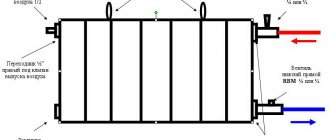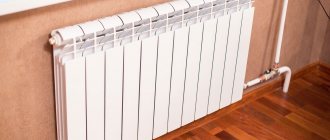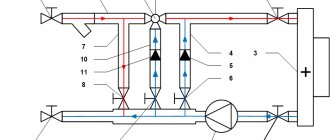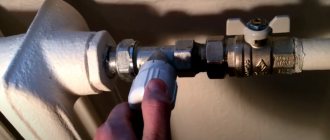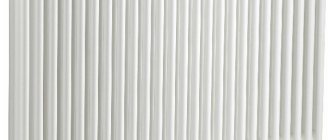Leading classification
This will depend on the type and quality of the material used in the manufacture of radiators. The main varieties include:
- made of cast iron;
- made of bimetal;
- made of aluminum;
- of steel.
Each of the materials has some disadvantages and a number of features, so to make a decision you will need to consider the main indicators in more detail.
Made from steel
They function perfectly in combination with an autonomous heating device, which is designed to heat a significant area. The choice of steel heating radiators is not considered an excellent option, since they are not able to withstand significant pressure. They are extremely resistant to corrosion, lightweight and heat transfer performance is quite satisfactory. Having an insignificant flow area, they rarely become clogged. But the working pressure is considered to be 7.5-8 kg/cm2, while the resistance to possible water hammer is only 13 kg/cm2. The heat transfer of the section is 150 W.
Steel
Made from bimetal
They do not have the disadvantages that are found in aluminum and cast iron products. The presence of a steel core is a characteristic feature, which made it possible to achieve colossal pressure resistance of 16 - 100 kg/cm2. The heat transfer of bimetallic radiators is 130 - 200 W, which is close to aluminum in terms of performance. They have a small cross-section, so over time there are no problems with contamination. Significant disadvantages include the prohibitively high cost of the products.
Bimetallic
Made from aluminum
Such devices have many advantages. They have excellent external characteristics and do not require special care. They are strong enough, which means you don’t have to worry about water hammer, as is the case with cast iron products. The working pressure is considered to be 12 – 16 kg/cm2, depending on the model used. Features also include a flow area that is equal to or less than the diameter of the risers. This allows the coolant to circulate inside the device at tremendous speed, which makes it impossible for sediment to deposit on the surface of the material. Most people mistakenly believe that too small a cross-section will inevitably lead to low heat transfer rates.
Aluminum
This opinion is erroneous, if only because the level of heat transfer from aluminum is much higher than, for example, that of cast iron. The cross section is compensated by the area of the fins. The heat output of aluminum radiators depends on various factors, including the model used, and can range from 137 to 210 W. Contrary to the characteristics given above, it is not recommended to use this type of equipment in apartments, since the products are not able to withstand sudden temperature changes and pressure surges inside the system (during the run of all devices). The material of an aluminum radiator deteriorates very quickly and cannot be subsequently restored, as is the case when using other materials.
Made from cast iron
The need for regular and very careful maintenance. A high rate of inertia is almost the main advantage of cast iron heating radiators. The level of heat transfer is also quite good. Such products do not heat up quickly, and they also give off heat for quite a long time. The heat output of one section of a cast iron radiator is equal to 80 - 160 W. But there are a lot of shortcomings here and the main ones are considered to be the following:
- Tangible weight of the structure.
- Almost complete lack of ability to resist water hammer (9 kg/cm2).
- There is a noticeable difference between the cross-section of the battery and the risers. This leads to slow circulation of the coolant and fairly rapid contamination.
Heat transfer from heating radiators in the table
Comparison by thermal power
If you carefully studied the previous section, you should understand that heat transfer is greatly influenced by air and coolant temperatures, and these parameters depend little on the radiator itself. But there is a third factor - the heat transfer surface area, here the design and shape of the product plays a big role. It is impossible to clearly compare a steel panel heater with a cast iron radiator; their surfaces are too different.
It is difficult to compare the heat output of flat panels and ribbed surfaces of complex configurations
The fourth factor influencing heat transfer is the material from which the heating device is made. Compare for yourself: 5 sections of the GLOBAL VOX aluminum radiator with a height of 600 mm will deliver 635 W at DT = 50 °C. A cast iron retro battery DIANA (GURATEC) for 5 sections of the same height will transmit only 530 W to the room under similar conditions (Δt = 50 °C). These data are published on the manufacturers' official websites.
Note. The power characteristics of aluminum and bimetallic heaters differ little; there is no point in comparing them.
You can try to compare aluminum with a steel panel radiator by taking the closest standard size that fits the dimensions. The length of a battery of 5 GLOBAL aluminum sections with a height of 600 mm will be approximately 400 mm, which corresponds to a KERMI 600 x 400 steel panel.
The table shows the thermal performance of 1 section made of aluminum and bimetal depending on the size and temperature difference Δt
Even if we take a three-row steel panel (type 30), we get 572 W at Δt = 50 °C versus 635 W for 5-section aluminum. Also keep in mind that the GLOBAL VOX radiator is much thinner, the depth of the device is 95 mm, and the KERMI panels are almost 160 mm. That is, the high heat transfer of aluminum sections makes it possible to reduce the dimensions of the heater.
In an individual heating system for a private home, batteries of the same power, made of different metals, will work differently. Therefore, the comparison is quite predictable:
- Bimetallic and aluminum products quickly heat up and cool down. By giving off more heat over a period of time, they cool the water returned to the system more.
- Steel panel radiators occupy a middle position, as they transfer heat less intensively. But they are cheaper and easier to install.
- The most inert and expensive are heaters made of cast iron; they are characterized by long heating and cooling, which causes a slight delay in the automatic regulation of coolant flow by thermostatic heads.
Formulas for calculating heater power for various rooms
The formula for calculating the heater power depends on the ceiling height. For rooms with ceiling height
- S – room area;
- ∆T – heat transfer of the heating device section.
For rooms with ceiling heights > 3 m, calculations are carried out according to the formula
- S – total area of the room;
- ∆T – heat transfer of a separate section of the battery;
- h – ceiling height.
These simple formulas will help you accurately calculate the required number of sections of the heating device. Before entering data into the formula, determine the real heat transfer of the section using the formulas given earlier! This calculation is suitable for an average incoming coolant temperature of 70˚ C. For other indicators, it is necessary to take into account the correction factor.
Let us give examples of calculations. Let's imagine that a room or non-residential premises has dimensions of 3 x 4 m, the ceiling height is 2.7 m (standard ceiling height in Soviet-built city apartments). Let's determine the volume of the room:
3 x 4 x 2.7 = 32.4 cubic meters.
Now let’s calculate the thermal power required for heating: multiply the volume of the room by the indicator required to heat one cubic meter of air:
Knowing the actual power of an individual radiator section, select the required number of sections, rounding it up. So, 5.3 is rounded to 6, and 7.8 – to 8 sections. When calculating the heating of adjacent rooms that are not separated by a door (for example, a kitchen separated from the living room by an arch without a door), the areas of the rooms are summed up. For a room with double-glazed windows or insulated walls, you can round down (insulation and double-glazed windows reduce heat loss by 15-20%), and in a corner room and rooms on high floors, add one or two sections “in reserve.”
Why doesn't the battery heat up?
But sometimes the power of the sections is recalculated based on the actual temperature of the coolant, and their number is calculated taking into account the characteristics of the room and installed with the necessary margin... and it’s cold in the house! Why is this happening? What are the reasons for this? Is it possible to correct this situation?
The reason for the decrease in temperature may be a decrease in water pressure from the boiler room or repairs from neighbors! If, during the renovation, a neighbor narrowed the hot water riser, installed a “warm floor” system, or began heating a loggia or glassed-in balcony on which he built a winter garden, the pressure of hot water entering your radiators will, of course, decrease.
But it is quite possible that the room is cold because you installed the cast iron radiator incorrectly. Typically, a cast iron battery is installed under a window so that the warm air rising from its surface creates a kind of thermal curtain in front of the window opening. However, with its back side, the massive battery heats not the air, but the wall! To reduce heat loss, glue a special reflective screen to the wall behind the heating radiators. Or you can purchase decorative cast-iron batteries in a retro style, which do not have to be mounted on the wall: they can be mounted at a considerable distance from the walls.
How to calculate radiator sections by room volume
This calculation takes into account not only the area, but also the height of the ceilings, because all the air in the room needs to be heated. So this approach is justified. And in this case the technique is similar. We determine the volume of the room, and then, according to the standards, we find out how much heat is needed to heat it:
- in a panel house, heating a cubic meter of air requires 41 W;
- in a brick house per m 3 - 34 W.
You need to heat the entire volume of air in the room, so it is more correct to calculate the number of radiators by volume
Let's calculate everything for the same room with an area of 16m2 and compare the results. Let the ceiling height be 2.7m. Volume: 16*2.7=43.2m3.
Next we will calculate for options in a panel and brick house:
- In a panel house. The heat required for heating is 43.2m 3 *41V=1771.2W. If we take all the same sections with a power of 170 W, we get: 1771 W/170 W = 10,418 pcs (11 pcs).
- In a brick house. The heat needed is 43.2m 3 *34W=1468.8W. We count the radiators: 1468.8W/170W=8.64pcs (9pcs).
As you can see, the difference is quite large: 11 pieces and 9 pieces. Moreover, when calculating by area, we got the average value (if rounded in the same direction) - 10 pcs.
General provisions and algorithm for thermal calculation of heating devices
The calculation of heating devices is carried out after the hydraulic calculation of the heating system pipelines using the following method. The required heat transfer of the heating device is determined by the formula:
, (3.1)
where is the heat loss of the room, W; when installing several heating devices in a room, the heat loss of the room is distributed equally between the devices;
— useful heat transfer of heating pipelines, W; determined by the formula:
, (3.2)
where is the specific heat transfer of 1 m of openly laid vertical/horizontal/ pipelines, W/m; is accepted according to the data in Table. 3 Appendix 9 depending on the temperature difference between the pipeline and the air;
— total length of vertical/horizontal/ pipelines in the room, m.
Actual heat output of the heating device:
, (3.4)
where is the nominal heat flow of the heating device (one section), W. Accepted according to the data in the table. 1 appendix 9;
- temperature pressure equal to the difference between half the sum of the coolant temperatures at the inlet and outlet of the heating device and the room air temperature:
, °C; (3.5)
where is the coolant flow through the heating device, kg/s;
— empirical coefficients. The parameter values, depending on the type of heating devices, coolant flow rate and flow pattern, are given in Table. 2 applications 9;
— correction factor, method of installing the device; is accepted according to the data in Table. 5 appendices 9.
The average water temperature in a heating device of a single-pipe heating system is generally determined by the expression:
, (3.6)
where is the water temperature in the hot main, °C;
— cooling of water in the supply line, °C;
— correction factors adopted according to table. 4 and table. 7 appendix 9;
- the sum of heat losses of the premises located upstream of the premises in question, counting along the movement of water in the riser, W;
— water flow in the riser, kg/s /determined at the stage of hydraulic calculation of the heating system/;
— heat capacity of water equal to 4187 J/(kg deg);
— coefficient of water flow into the heating device. Accepted according to the table. 8 appendices 9.
The coolant flow through the heating device is determined by the formula:
, (3.7)
The cooling of water in the supply line is found according to the approximate relationship:
, (3.8)
where is the length of the main line from the individual heating point to the design riser, m.
The actual heat transfer of the heating device must be no less than the required heat transfer, that is. The opposite relationship is allowed if the discrepancy does not exceed 5%.
Dependence of radiator power on connection and location
In addition to all the parameters described above, the heat transfer of the radiator varies depending on the type of connection. A diagonal connection with a supply from above is considered optimal; in this case, there is no loss of thermal power. The largest losses are observed with lateral connections - 22%. All others are average in efficiency. Approximate percentage losses are shown in the figure.
Heat loss on radiators depending on connection
The actual power of the radiator also decreases in the presence of obstructing elements. For example, if a window sill hangs from above, the heat transfer drops by 7-8%; if it does not completely block the radiator, then the loss is 3-5%. When installing a mesh screen that does not reach the floor, the losses are approximately the same as in the case of an overhanging window sill: 7-8%. But if the screen completely covers the entire heating device, its heat transfer is reduced by 20-25%.
The amount of heat depends on the installation
The amount of heat depends on the installation location
Characteristics and Features
The secret of their popularity is simple: in our country, the coolant in centralized heating networks is such that it even dissolves or erases metals. In addition to a huge amount of dissolved chemical elements, it contains sand, particles of rust that have fallen off pipes and radiators, “tears” from welding, bolts forgotten during repairs and a lot of other things that are unknown how they got inside. The only alloy that doesn’t care about all this is cast iron. Stainless steel also does this well, but one can only guess how much such a battery will cost.
MS-140 - an undying classic
And another secret of the MS-140’s popularity is its low price. It has significant differences between different manufacturers, but the approximate cost of one section is about $5 (retail).
Advantages and disadvantages of cast iron radiators
It is clear that a product that has not left the market for many decades has some unique properties. The advantages of cast iron batteries include:
- Low chemical activity, which ensures long service life in our networks. Officially, the warranty period is from 10 to 30 years, and the service life is 50 years or more.
- Low hydraulic resistance. Only radiators of this type can be installed in systems with natural circulation (some also use aluminum and steel tubular ones).
- High temperature of the working environment. No other radiator can withstand temperatures above +130 o C. Most of them have a higher limit of +110 o C.
- Low price.
- High heat dissipation. For all other cast iron radiators, this characteristic is in the “disadvantages” section. Only MS-140 and MS-90 have a thermal power of one section comparable to aluminum and bimetallic ones. For MS-140, heat transfer is 160-185 W (depending on the manufacturer), for MS 90 - 130 W.
- They do not corrode when the coolant is drained.
MS-140 and MS-90 - difference in section depth
Some properties are a plus under some circumstances, and a minus under others:
- Large thermal inertia. It may take an hour or more until the MS-140 section warms up. And all this time the room does not heat up. But on the other hand, this is good if the heating is turned off, or a conventional solid fuel boiler is used in the system: the heat accumulated by the walls and water maintains the temperature in the room for a long time.
- Large cross-section of channels and collectors. On the one hand, even a bad and dirty coolant will not be able to clog them in just a few years. Therefore, cleaning and washing can be carried out periodically. But due to the large cross-section, more than a liter of coolant “fits” in one section. And it needs to be “driven” through the system and heated, which means extra costs for equipment (a more powerful pump and boiler) and fuel.
“Pure” disadvantages are also present:
Heavy weight. The weight of one section with an axial distance of 500 mm is from 6 kg to 7.12 kg. And since you usually need from 6 to 14 pieces per room, you can calculate what the mass will be. And you will have to wear it, and also hang it on the wall. This is another drawback: difficult installation. And all because of the same weight. Fragility and low working pressure. Not the most pleasant characteristics
Despite their massive size, cast iron products must be handled with care: they may burst upon impact. The same fragility leads to not the highest operating pressure: 9 atm
Pressure testing - 15-16 atm. The need for regular coloring. All sections come only primed. They will need to be painted often: once every year or two.
Thermal inertia is not always a bad thing...
Application area
As you can see, there are more than serious advantages, but there are also disadvantages. If we summarize everything, we can determine the scope of their use:
- Networks with very low coolant quality (Ph above 9) and a large number of abrasive particles (without mud traps and filters).
- In individual heating when using solid fuel boilers without automation.
- In networks with natural circulation.
Comparison by other characteristics
One feature of battery operation – inertia – has already been mentioned above. But in order for the comparison of heating radiators to look objective, in addition to heat transfer, other important parameters should be taken into account:
- working and maximum coolant pressure;
- amount of water held;
- weight.
The operating pressure limitation determines whether the heating device can be installed in multi-storey buildings, where the height of water lifting by network pumps can reach hundreds of meters. The parameter does not matter for private houses, where the pressure in the system is low, maximum 3 Bar.
Comparing the capacity of radiators can give an idea of the total amount of water in the network that will have to be heated. Well, the weight of the product is important when choosing the installation location and method of attaching the battery.
As an example, below is a comparison table of the characteristics of various heating radiators of the same size:
Note. In the table, a heating device consisting of 5 sections is taken as 1 unit, except for the steel one, which is a single panel.
What determines the power of cast iron radiators
Cast iron sectional radiators are a method of heating buildings that has been proven for decades. They are very reliable and durable, however, there are a few things to keep in mind. So, their heat transfer surface is somewhat small; about a third of the heat is transferred by convection. We first recommend watching the advantages and features of cast iron radiators in this video
The area of the MS-140 cast iron radiator section is (in terms of heating area) only 0.23 m2, weighs 7.5 kg and holds 4 liters of water. This is quite small, so each room should have at least 8-10 sections. The area of a cast iron radiator section should always be taken into account when choosing, so as not to get hurt. By the way, the heat supply in cast iron batteries is also somewhat slower. The power of a cast iron radiator section is usually about 100-200 W.
The operating pressure of a cast iron radiator is the maximum water pressure it can withstand. Typically this value fluctuates around 16 atm. And heat transfer shows how much heat one section of the radiator gives off.
Radiator manufacturers often overestimate heat output. For example, you can see that cast iron radiators heat transfer at delta t 70 °C is 160/200 W, but the meaning of this is not entirely clear. The designation “delta t” is actually the difference between the average air temperatures in the room and in the heating system, that is, with a delta t of 70 °C, the operating schedule of the heating system should be: supply 100 °C, return 80 °C. It is already clear that these figures do not correspond to reality. Therefore, it would be correct to consider the heat transfer of the radiator at delta t 50 °C. Nowadays, cast iron radiators are widely used, the heat transfer of which (and more specifically, the power of the cast iron radiator section) fluctuates around 100-150 W.
A simple calculation will help us determine the required thermal power. The area of your room in mdelta should be multiplied by 100 W. That is, for a room with an area of 20 mdelta, you will need a radiator with a power of 2000 W. Be sure to keep in mind that if the room has double-glazed windows, you should subtract 200 W from the result, and if the room has several windows, the windows are too large or it is corner, add 20-25%. If you do not take these points into account, the radiator will not work efficiently, and the result will be an unhealthy microclimate in your home. You should also not choose a radiator based on the width of the window under which it will be located, and not on its power.
If the power of cast iron radiators in your home is higher than the heat loss of the room, the devices will overheat. The consequences may not be very pleasant.
- First of all, when dealing with the stuffiness that arises due to overheating, you will have to open windows, balconies, etc., creating drafts that create discomfort and illness for the whole family, and especially for children.
- Secondly, due to the highly heated surface of the radiator, oxygen burns, air humidity sharply decreases, and even the smell of burnt dust appears. This brings particular suffering to allergy sufferers, since dry air and burnt dust irritate the mucous membranes and cause an allergic reaction. Yes, this also affects healthy people.
- Finally, incorrectly selected power of cast iron radiators is a consequence of uneven heat distribution and constant temperature changes. Radiator thermostatic valves are used to regulate the temperature and maintain it. However, it is useless to install them on cast iron radiators.
If the thermal power of your radiators is less than the heat loss of the room, this problem can be solved by creating additional electric heating or even completely replacing heating devices. And this will cost you time and money.
Therefore, it is very important, taking into account the above factors, to choose the most suitable radiator for your room.
How much heat is needed for heating?
To accurately calculate the required amount of heat for a room, many factors should be taken into account : the climatic features of the area, the cubic capacity of the building, possible heat loss from the housing (the number of windows and doors, building material, the presence of insulation, etc.). This calculation system is quite labor-intensive and is used in rare cases .
Basically, the calculation of heat is determined on the basis of established indicative coefficients: for a room with ceilings no higher than 3 meters, 1 kW of thermal energy is required per 10 m2 . For the northern regions, the figure increases to 1.3 kW.
For example, a room with an area of 80 m2 requires 8 kW of power for optimal heating. For the northern regions, the amount of thermal energy will increase to 10.4 kW
Advantages and disadvantages of cast iron radiators
Cast iron radiators are manufactured using casting. The cast iron alloy has a homogeneous composition. Such heating devices are widely used for both central heating systems and autonomous heating systems. The sizes of cast iron radiators can vary.
Among the advantages of cast iron radiators are:
- Possibility of use for coolant of any quality. Suitable even for coolant with a high alkali content. Cast iron is a durable material and is not easy to dissolve or scratch;
- resistance to corrosion processes. Such radiators can withstand coolant temperatures up to +150 degrees;
- excellent heat storage properties. An hour after turning off the heating, the cast iron radiator will radiate 30% of the heat. Therefore, cast iron radiators are ideal for systems with irregular heating of the coolant;
- do not require frequent care. And this is mainly due to the fact that the cross-section of cast iron radiators is quite large;
- long service life - about 50 years. If the coolant is of high quality, then the radiator can last a century;
- reliability and strength. The wall thickness of such batteries is large;
- high heat radiation. For comparison: bimetallic heaters transfer 50% of the heat, and cast iron radiators – 70% of the heat;
- The price for cast iron radiators is quite reasonable.
Among the disadvantages are:
- heavy weight Only one section can weigh about 7 kg;
- installation should be done on a previously prepared, reliable wall;
- Radiators must be coated with paint. If after a while it is necessary to paint the battery again, the old layer of paint must be sanded. Otherwise, heat transfer will decrease;
- increased fuel consumption. One segment of a cast iron battery contains 2-3 times more liquid than other types of batteries.
Additional factors affecting heat transfer
This indicator is also affected by:
- Connection type.
- Features of accommodation.
The radiator can be connected in the following ways:
Most manufacturers believe that the owner will make
a diagonal connection, because it is the most effective. It consists of connecting the inlet pipe to the pipe located at the top of the heating device, and connecting the outlet pipe to the pipe located at the bottom of the opposite end. Thanks to this, the coolant can easily fill all sections and transfer heat to every particle of the heating radiator. In this case, it is not necessary to create very high pressure to move water or other heated liquid.
Lateral connection involves connecting pipes to the same section. The inlet pipe is located at the top, the outlet pipe at the bottom.
This leads to poor heating of the last ribs. According to statistics, heat loss is 7%. The lower connection diagram results in 20% losses. Heat transfer losses in the last two connection schemes to a heating device can be minimized by using forced circulation of heated liquid. Even a small pressure is enough to completely warm up all sections.
Battery placement is very important. If it is installed crookedly, air pockets will form in some sections. Heat transfer will be less.
The loss of heat transfer can be like this:
- 7-10% - if the permissible distance between the device and the window sill is exceeded. It should be 10-15 cm;
- 5% - if the distance between the wall and the battery is reduced. The optimal size is 3-5 cm;
- 7% - in a situation where the distance between the floor and the radiator is not maintained. It should be 10-15 cm.
Connection method
Not everyone understands that the layout of heating system pipes and proper connection affect the quality and efficiency of heat transfer. Let's look at this fact in more detail.
There are 4 ways to connect a radiator:
- Lateral. This option is most often used in city apartments in multi-storey buildings. There are more apartments in the world than private houses, so manufacturers use this type of connection as a nominal way to determine the heat transfer of radiators. To calculate it, a coefficient of 1.0 is used.
- Diagonal. An ideal connection, because the coolant passes throughout the entire device, evenly distributing heat throughout its volume. Typically this type is used if the radiator has more than 12 sections. When calculating, a multiplying factor of 1.1–1.2 is used.
- Lower. In this case, the supply and return pipes are connected from the bottom of the radiator. Typically this option is used for hidden pipe wiring. This type of connection has one drawback - heat loss is 10%.
- Single-pipe. This is essentially a bottom connection. It is usually used in the Leningradka pipe distribution system. And here there were heat losses, although they were several times greater - 30–40%.
Adjustment depending on heating system mode
Manufacturers indicate the maximum power of radiators in the passport data: in high-temperature mode of use - the coolant temperature in the supply is 90 o C, in the return - 70 o C (indicated by 90/70) in the room there should be 20 o C. But in this mode, modern systems The heating works very rarely. Typically, a medium power mode of 75/65/20 or even a low temperature mode with parameters of 55/45/20 is used. It is clear that the calculation needs to be adjusted.
To take into account the operating mode of the system, it is necessary to determine the temperature pressure of the system. Temperature pressure is the difference between the temperature of the air and the heating devices. In this case, the temperature of the heating devices is considered as the arithmetic average between the supply and return values.
It is necessary to take into account the characteristics of the premises and climate in order to correctly calculate the number of radiator sections
To make it clearer, we will calculate cast iron heating radiators for two modes: high temperature and low temperature, standard size sections (50cm). The room is the same: 16m2. One cast iron section heats 1.5 m 2 in high temperature mode 90/70/20. Therefore, we need 16m 2 / 1.5 m 2 = 10.6 pcs. Round up - 11 pcs. The system plans to use a low temperature mode of 55/45/20. Now let’s find the temperature difference for each of the systems:
- high temperature 90/70/20- (90+70)/2-20=60 o C;
- low temperature 55/45/20 - (55+45)/2-20=30 o C.
That is, if a low-temperature operating mode is used, twice as many sections will be needed to provide the room with heat. For our example, a room of 16 m2 requires 22 sections of cast iron radiators. The battery turns out to be big. This, by the way, is one of the reasons why this type of heating device is not recommended for use in networks with low temperatures.
With this calculation, you can also take into account the desired air temperature. If you want the room to be not 20 o C, but, for example, 25 o C, simply calculate the thermal pressure for this case and find the desired coefficient. Let's do the calculation for the same cast iron radiators: the parameters will be 90/70/25. We calculate the temperature difference for this case (90+70)/2-25=55 o C. Now we find the ratio 60 o C/55 o C=1.1. To ensure a temperature of 25 o C you need 11 pcs * 1.1 = 12.1 pcs.
How to correctly calculate the actual heat transfer of batteries
You should always start with the technical data sheet that is attached to the product by the manufacturer. In it you will definitely find the data you are interested in, namely the thermal power of one section or panel radiator of a certain standard size. But do not rush to admire the excellent performance of aluminum or bimetallic batteries; the figure indicated in the passport is not final and requires adjustment, for which you need to calculate the heat transfer.
You can often hear the following judgments: the power of aluminum radiators is the highest, because it is well known that the heat transfer of copper and aluminum is the best among other metals. Copper and aluminum have the best thermal conductivity, this is true, but heat transfer depends on many factors, which will be discussed below.
The heat transfer stated in the heating device’s passport corresponds to the truth when the difference between the average temperature of the coolant (supply t + return t)/2 and in the room is 70 °C. Using the formula, this is expressed as follows:
For reference. In the documentation for products from different companies, this parameter can be designated differently: dt, Δt or DT, and sometimes it is simply written “at a temperature difference of 70 °C”.
What does it mean when the documentation for a bimetallic radiator says: the thermal power of one section is 200 W at DT = 70 °C? The same formula will help you figure it out, but you just need to substitute the known value of room temperature – 22 °C – into it and carry out the calculation in reverse order:
Knowing that the temperature difference in the supply and return pipelines should not be more than 20 °C, their values must be determined as follows:
Now it is clear that 1 section of the bimetallic radiator from the example will give off 200 W of heat, provided that there is water heated to 102 °C in the supply pipeline, and a comfortable temperature of 22 °C is established in the room. The first condition is impossible to fulfill, since in modern boilers heating is limited to 80 °C, which means that the battery will never be able to deliver the declared 200 W of heat. And it is a rare case that the coolant in a private house is heated to such an extent; the usual maximum is 70 °C, which corresponds to DT = 38-40 °C.
Calculation procedure
It turns out that the actual power of the heating battery is much lower than stated in the passport, but to select it you need to understand how much. There is a simple way to do this: applying a reduction factor to the initial value of the heater’s thermal power. Below is a table that shows the values of the coefficients by which you need to multiply the heat transfer rating of the radiator depending on the DT value:
The algorithm for calculating the real heat transfer of heating devices for your individual conditions is as follows:
- Determine what the temperature in the house and water in the system should be.
- Substitute these values into the formula and calculate your real Δt.
- Find the corresponding coefficient in the table.
- Multiply the rated heat transfer value of the radiator by it.
- Calculate the number of heating devices needed to heat the room.
For the example above, the thermal power of 1 section of a bimetallic radiator will be 200 W x 0.48 = 96 W. Therefore, to heat a room with an area of 10 m2, you will need 1 thousand W of heat or 1000/96 = 10.4 = 11 sections (rounding always goes up).
The presented table and calculation of the heat transfer of batteries should be used when the documentation indicates Δt equal to 70 °C. But it happens that for different devices from some manufacturers the radiator power is given at Δt = 50 °C. Then you can’t use this method, it’s easier to dial the required number of sections according to the passport characteristics, just take their number with a margin of one and a half.
For reference. Many manufacturers indicate heat transfer values under the following conditions: supply t = 90 °C, return t = 70 °C, air t = 20 °C, which corresponds to Δt = 50 °C.
Adjusting results
In order to obtain a more accurate calculation, you need to take into account as many factors as possible that reduce or increase heat loss. This is what the walls are made of and how well they are insulated, how large the windows are and what kind of glazing they have, how many walls in the room face the street, etc. To do this, there are coefficients by which you need to multiply the found values of heat loss in the room.
The number of radiators depends on the amount of heat loss
Windows account for 15% to 35% of heat loss. The specific figure depends on the size of the window and how well it is insulated. Therefore, there are two corresponding coefficients:
- ratio of window area to floor area:
- 10% — 0,8
- 20% — 0,9
- 30% — 1,0
- 40% — 1,1
- 50% — 1,2
- glazing:
- three-chamber double-glazed window or argon in a two-chamber double-glazed window - 0.85
- ordinary double-glazed window - 1.0
- regular double frames - 1.27.
- brick walls two bricks thick are considered the norm - 1.0
- insufficient (absent) - 1.27
- good - 0.8
Walls and roof
To account for losses, the material of the walls, the degree of thermal insulation, and the number of walls facing the street are important. Here are the coefficients for these factors.
Presence of external walls:
- interior space - no losses, coefficient 1.0
- one - 1.1
- two - 1.2
- three - 1.3
The amount of heat loss is influenced by whether the room is located on top or not. If there is a habitable heated room on top (the second floor of a house, another apartment, etc.), the reduction factor is 0.7, if there is a heated attic - 0.9. It is generally accepted that an unheated attic does not affect the temperature in any way (coefficient 1.0).
It is necessary to take into account the characteristics of the premises and climate in order to correctly calculate the number of radiator sections
If the calculation was carried out by area, and the ceiling height is non-standard (a height of 2.7 m is taken as the standard), then a proportional increase/decrease using a coefficient is used. It is considered easy. To do this, divide the actual ceiling height in the room by the standard 2.7 m. You get the required coefficient.
Let's do the math for example: let the ceiling height be 3.0m. We get: 3.0m/2.7m=1.1. This means that the number of radiator sections that was calculated by area for a given room must be multiplied by 1.1.
All these norms and coefficients were determined for apartments. To take into account the heat loss of a house through the roof and basement/foundation, you need to increase the result by 50%, that is, the coefficient for a private house is 1.5.
Climatic factors
Adjustments can be made depending on average winter temperatures:
- -10 o C and above - 0.7
- -15 o C - 0.9
- -20 o C - 1.1
- -25 o C - 1.3
- -30 o C - 1.5
Having made all the required adjustments, you will receive a more accurate number of radiators required to heat the room, taking into account the parameters of the premises. But these are not all the criteria that influence the power of thermal radiation. There are also technical subtleties, which we will discuss below.
Radiator heat transfer, what does this indicator mean?
The term heat transfer means the amount of heat that a heating battery transfers to a room over a certain period of time. There are several synonyms for this indicator: heat flow; thermal power, device power. The heat output of heating radiators is measured in Watts (W). Sometimes in the technical literature you can find a definition of this indicator in calories per hour, with 1 W = 859.8 cal/h.
Heat transfer from radiators occurs through three processes:
- heat transfer;
- convection;
- radiation (radiation).
Each heating device uses all three heat transfer options, but their ratio differs for different models. Previously, it was customary to call radiators devices in which at least 25% of the thermal energy is released as a result of direct radiation, but now the meaning of this term has expanded significantly. Nowadays, convector-type devices are often called this.
Calculation of different types of radiators
If you are planning to install sectional radiators of a standard size (with an axial distance of 50 cm in height) and have already chosen the material, model and desired size, there should not be any difficulties in calculating their number. Most reputable companies that supply good heating equipment have on their website the technical data of all modifications, including thermal power. If it is not the power that is indicated, but the coolant flow rate, then it is easy to convert to power: the coolant flow rate of 1 l/min is approximately equal to the power of 1 kW (1000 W).
The axial distance of the radiator is determined by the height between the centers of the holes for supplying/removing coolant.
To make life easier for customers, many websites install a specially designed calculator program. Then the calculation of heating radiator sections comes down to entering data on your premises in the appropriate fields. And at the output you have the finished result: the number of sections of this model in pieces.
The axial distance is determined between the centers of the coolant holes
But if you’re just evaluating possible options, then it’s worth considering that radiators of the same size made of different materials have different thermal power. The method for calculating the number of sections of bimetallic radiators is no different from calculating aluminum, steel or cast iron. Only the thermal power of one section can be different.
To make it easier to calculate, there are averaged data that you can use as a guide. For one radiator section with an axial distance of 50 cm, the following power values are accepted:
- aluminum - 190W
- bimetallic - 185W
- cast iron - 145W.
If you are just figuring out which material to choose, you can use this data. For clarity, we present the simplest calculation of sections of bimetallic heating radiators, which takes into account only the area of the room.
Technical characteristics of cast iron radiators
The technical parameters of cast iron batteries are related to their reliability and endurance. The main characteristics of a cast iron radiator, like any heating device, are heat transfer and power. As a rule, manufacturers indicate the power of cast iron heating radiators for one section. The number of sections may vary. As a rule, from 3 to 6. But sometimes it can reach 12. The required number of sections is calculated separately for each apartment.
The number of sections depends on a number of factors:
- room area;
- room height;
- number of windows;
- floor;
- presence of installed double-glazed windows;
- corner placement of the apartment.
The price given for cast iron heating radiators is per section, and may vary depending on the manufacturer. The heat dissipation of batteries depends on what material they are made of. In this regard, cast iron is inferior to aluminum and steel.
Other technical parameters include:
- maximum operating pressure – 9-12 bar;
- maximum coolant temperature – 150 degrees;
- one section holds about 1.4 liters of water;
- the weight of one section is approximately 6 kg;
- section width 9.8 cm.
Such batteries should be installed with a distance between the radiator and the wall of 2 to 5 cm. The installation height above the floor should be at least 10 cm. If there are several windows in the room, the batteries should be installed under each window. If the apartment is corner, then it is recommended to insulate the walls externally or increase the number of sections.
It should be noted that cast iron batteries are often sold unpainted. In this regard, after purchase, they must be coated with a heat-resistant decorative composition and must first be stretched.
Among domestic radiators, one can distinguish the ms 140 model. For cast iron heating radiators ms 140, the technical specifications are given below:
- heat transfer of the MS section 140 – 175 W;
- height – 59 cm;
- The radiator weighs 7 kg;
- capacity of one section - 1.4 l;
- section depth is 14 cm;
- section power reaches 160 W;
- section width is 9.3 cm;
- the maximum coolant temperature is 130 degrees;
- maximum operating pressure – 9 bar;
- the radiator has a sectional design;
- crimping pressure is 15 bar;
- the volume of water in one section is 1.35 liters;
- Heat-resistant rubber is used as a material for intersection gaskets.
It is worth noting that MS 140 cast iron radiators are reliable and durable. And the price is quite affordable. Which determines their demand in the domestic market.
Features of choosing cast iron radiators
To choose which cast iron heating radiators are best suited for your conditions, you need to take into account the following technical parameters:
- heat dissipation Select based on the size of the room;
- radiator weight;
- power;
- dimensions: width, height, depth.
To calculate the thermal power of a cast iron battery, you need to be guided by the following rule: for a room with 1 outer wall and 1 window, you need 1 kW of power per 10 sq.m. room area; for a room with 2 external walls and 1 window - 1.2 kW; for heating a room with 2 external walls and 2 windows - 1.3 kW.
If you decide to buy cast iron heating radiators, you should consider the following nuances:
- if the ceiling is higher than 3 m, the required power will increase proportionally;
- if the room has double-glazed windows, then the battery power can be reduced by 15%;
- If there are several windows in the apartment, then a radiator must be installed under each of them.
Modern market
Imported batteries have a perfectly smooth surface, they are of higher quality and look more aesthetically pleasing. True, their cost is high.
Among domestic analogues, we can highlight cast iron radiators Konner, which are in good demand today. They are characterized by a long service life, reliability, and fit perfectly into a modern interior. Konner heating cast iron radiators are available in any configuration.
- How to fill water into an open and closed heating system?
- Popular floor-standing gas boiler made in Russia
- How to properly bleed air from a heating radiator?
- Expansion tank for closed heating: device and principle of operation
- Gas double-circuit wall-mounted boiler Navien: error codes for malfunctions
Recommended reading
2016–2017 — Leading heating portal. All rights reserved and protected by law
Copying site materials is prohibited. Any copyright infringement will result in legal liability. Contacts
Determining the number of radiators for single-pipe systems
There is another very important point: all of the above is true for a two-pipe heating system, when a coolant with the same temperature enters the input of each radiator. A single-pipe system is considered much more complex: there, increasingly colder water flows to each subsequent heating device. And if you want to calculate the number of radiators for a one-pipe system, you need to recalculate the temperature every time, and this is difficult and time-consuming. Which exit? One of the possibilities is to determine the power of the radiators as for a two-pipe system, and then, in proportion to the drop in thermal power, add sections to increase the heat transfer of the battery as a whole.
In a single-pipe system, increasingly colder water flows to each radiator
Let's explain with an example. The diagram shows a single-pipe heating system with six radiators. The number of batteries was determined for two-pipe wiring. Now we need to make an adjustment. For the first heating device everything remains the same. The second one receives coolant with a lower temperature. We determine the % drop in power and increase the number of sections by the corresponding value. In the picture it turns out like this: 15kW-3kW=12kW. We find the percentage: the temperature drop is 20%. Accordingly, to compensate, we increase the number of radiators: if 8 pieces were needed, there will be 20% more - 9 or 10 pieces. This is where knowing the room will come in handy: if it’s a bedroom or a children’s room, round up, if it’s a living room or other similar room, round down. You also take into account the location relative to the cardinal directions: in the north you round up, in the south you round down.
In single-pipe systems, it is necessary to add sections to radiators located further along the branch
This method is clearly not ideal: after all, it turns out that the last battery in the branch will have to be simply enormous in size: judging by the diagram, a coolant with a specific heat capacity equal to its power is supplied to its input, and in practice it is unrealistic to remove all 100%. Therefore, usually when determining the power of a boiler for single-pipe systems, they take a certain reserve, install shut-off valves and connect radiators through a bypass so that the heat transfer can be adjusted and thus compensate for the drop in coolant temperature. One thing follows from all this: the number and/or size of radiators in a single-pipe system must be increased, and more and more sections must be installed as you move away from the beginning of the branch.
What to consider when calculating
Calculation of heating radiators
Be sure to take into account:
- The material from which the heating battery is made.
- Its dimensions.
- The number of windows and doors in the room.
- The material from which the house is built.
- The direction of the world in which the apartment or room is located.
- Availability of thermal insulation of the building.
- Type of pipe system layout.
And this is only a small part of what needs to be taken into account when calculating the power of a heating radiator. Don’t forget about the regional location of the house, as well as the average street temperature.
There are two ways to calculate the heat transfer of a radiator:
- Regular - using paper, pen and calculator. The calculation formula is known, and it uses the main indicators - the thermal output of one section and the area of the heated room. Coefficients are also added - decreasing and increasing, which depend on the previously described criteria.
- Using an online calculator. It is an easy-to-use computer program into which certain data about the size and design of the house is loaded. It gives a fairly accurate indicator, which is taken as the basis for designing a heating system.
For the common man, both options are not the easiest way to determine the heat transfer of a heating battery. But there is another method for which a simple formula is used - 1 kW per 10 m² of area. That is, to heat a room of 10 square meters, you will need only 1 kilowatt of thermal energy. Knowing the heat transfer rate of one section of a heating radiator, you can accurately calculate how many sections need to be installed in a particular room.
Let's look at a few examples of how to correctly carry out this calculation. Different types of radiators have a large size range, depending on the center distance. This is the size between the axes of the lower and upper manifold. For the bulk of heating batteries, this figure is either 350 mm or 500 mm. There are other parameters, but these are more common than others.
This is the first one. Secondly, there are several types of heating devices made of various metals on the market. Each metal has its own heat transfer, and this will have to be taken into account when calculating. By the way, everyone decides for themselves which radiator to choose and install in their home.
Calculation of heating radiators by area
The easiest way. Calculate the amount of heat required for heating, based on the area of the room in which the radiators will be installed. You know the area of each room, and the heat requirement can be determined according to SNiP building codes:
- for the average climate zone, 60-100 W are required for heating 1 m 2 of living space;
- for areas above 60 o, 150-200 W are required.
Based on these standards, you can calculate how much heat your room will require. If the apartment/house is located in the middle climate zone, heating an area of 16 m 2 will require 1600 W of heat (16*100=1600). Since the standards are average, and the weather is not constant, we believe that 100W is required. Although, if you live in the south of the middle climate zone and your winters are mild, count 60W.
